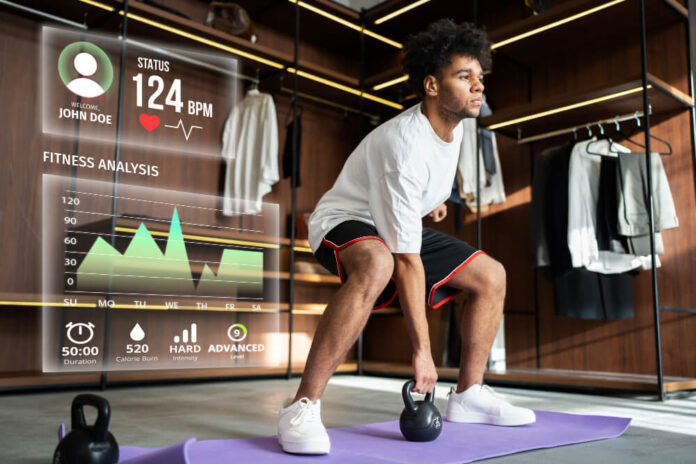Smartphones have quickly become essential companions for people around the globe. According to statistics, there are now 6.93 billion active smartphone users globally. This widespread connectivity has created a significant surge in market growth for fitness applications.
Fitness apps have dramatically transformed how people approach health and fitness. Boasting features like custom diet plans and workout tracking capabilities, fitness apps have altered people’s views of wellness.
But for any successful app to be created, it requires thorough preparation, creative brainstorming sessions, technological knowledge, and patience. These must all come together seamlessly in order for the app to be successful.
So, in this guide, we will be showing you all the steps you need to develop and create your own fitness app. From understanding market environments and target audiences to crafting user-friendly interfaces and putting cutting-edge technologies into play, we will uncover all of these details and reveal the tactics necessary for developing an engaging fitness app.
Steps for Developing a Fitness App
#1: Understand the Market and Identify the Niche
Before learning how to create your own fitness app, conducting extensive market research is vitally important. This includes learning everything there is to know about the current state of the fitness app market and understanding competition and customer preferences.
Focusing on defining and targeting the appropriate niche or target market – be it runners, yoga enthusiasts, or people searching for weight loss solutions – to gain a competitive advantage is of critical importance.
Doing this enables you to offer features and experiences tailored specifically for their user engagement and retention.
#2: Define the Features and Functionality
Once the target audience has been determined, the next thing to do is to define the features and functionality of the app.
Workout tracking, exercise libraries with instructional videos, progress tracking, dietary advice, and social integration for encouragement from the community are examples of essential elements you should consider including in your fitness app.
UX/UI designers, dietitians, and fitness experts should work together to provide a smooth user experience and improve the feature set.
#3: Establish a Model and Develop the User Interface
After the feature set is established, the user interface (UI) must be designed and a prototype made. Early in the development phase, prototyping enables testing of the app’s functionality and feedback collection.
Improving user engagement and retention requires an interface that is easy to use and has straightforward navigation. The usefulness and attractiveness of the app can be improved by adding interactive elements, readable text, and eye-catching images.
#4: Technological Development and Integration
Developers typically include designing the app’s architecture, frontend, and backend development, and the integration of necessary technologies as part of its development phase.
Cross-platform frameworks such as React Native or Flutter may be utilized, depending on the app’s complexity. Native development on platforms like iOS or Android could also be considered.
Furthermore, adding APIs with features such as payment processing, wearable device compatibility, or geolocation can enhance functionality further and add connections with users.
#5: Testing and Quality Assurance
To ensure the reliability, efficiency, and security of any app, thorough testing must take place. Usability testing focuses on user experience, while performance and scalability tests evaluate responsiveness, and functional tests test features’ functionality.
To further secure user privacy and reduce risks, doing security audits and following data protection laws are essential factors to take into account.
#6: Beta Testing and Iterative Refinement
To gather feedback and conduct real-world testing, a small sample of users is given access to the app during beta testing.
Beta testers find issues and make suggestions for improvements, giving important insights into the usability of the app. Through iterative refinement based on user feedback, developers may improve the overall user experience, fix bugs, and optimize features.
Maintaining the app’s competitiveness in the market and meeting user expectations require constant iteration and improvement.
#7: Create a Deployment and Launch Strategy
Creating a thorough deployment and launch plan is crucial for successful distribution as the app approaches completion.
Consider submitting and optimizing an app store listing, running marketing campaigns that target specific user demographics, and building relationships with fitness influencers or companies to increase reach are all part of the process.
Press releases, email marketing campaigns, and social media can all help promote its launch and drive user acquisition.
#8: Post-Launch Support and Maintenance
After the app is launched, the journey doesn’t end there. Continuing support and maintenance are essential for maintaining user interest and resolving new problems.
This entails keeping an eye on user reviews and app performance indicators, issuing updates often that include bug fixes and new features, and offering helpful customer service channels.
Long-term success is facilitated by interacting with the user community via forums, social media, and in-app messaging, which creates a sense of loyalty and belonging.
Final Note
Building a fitness app can be an extensive, time-consuming endeavor that requires planning, teamwork, and creativity from developers.
By understanding market needs, targeting demographics, or prioritizing user-centric design features and functionality, an app may become engaging to users while making an impactful statement about health and fitness.
With meticulous attention paid to every detail and dedicated development efforts, overcoming the challenges associated with app creation can lead to a fulfilling and prosperous launch for everyone involved. We believe the tips given above should help!
















